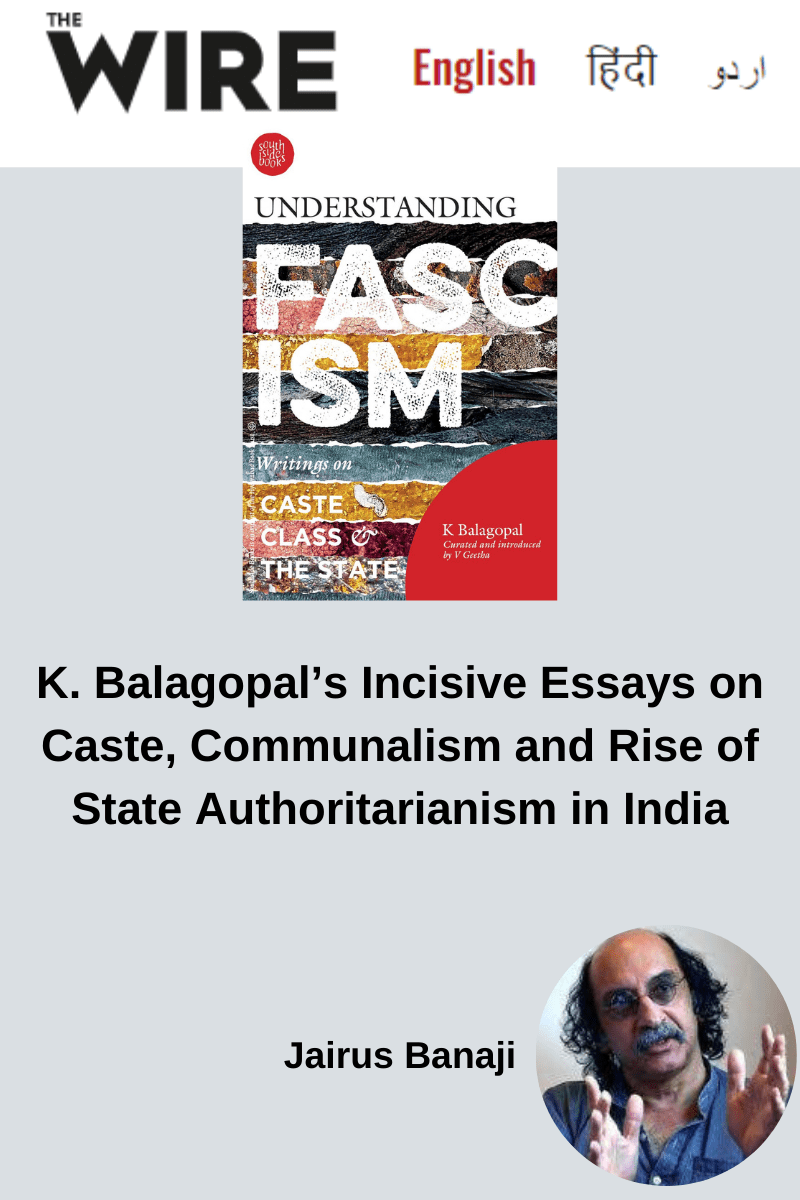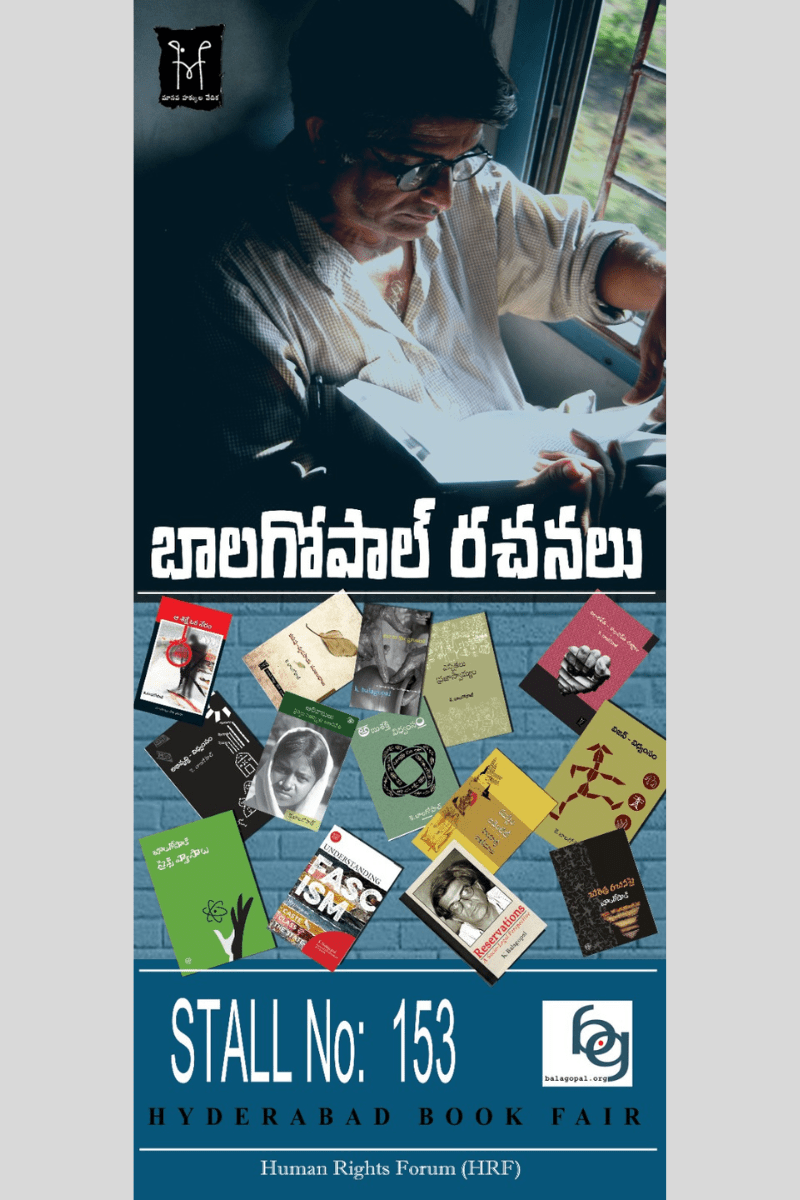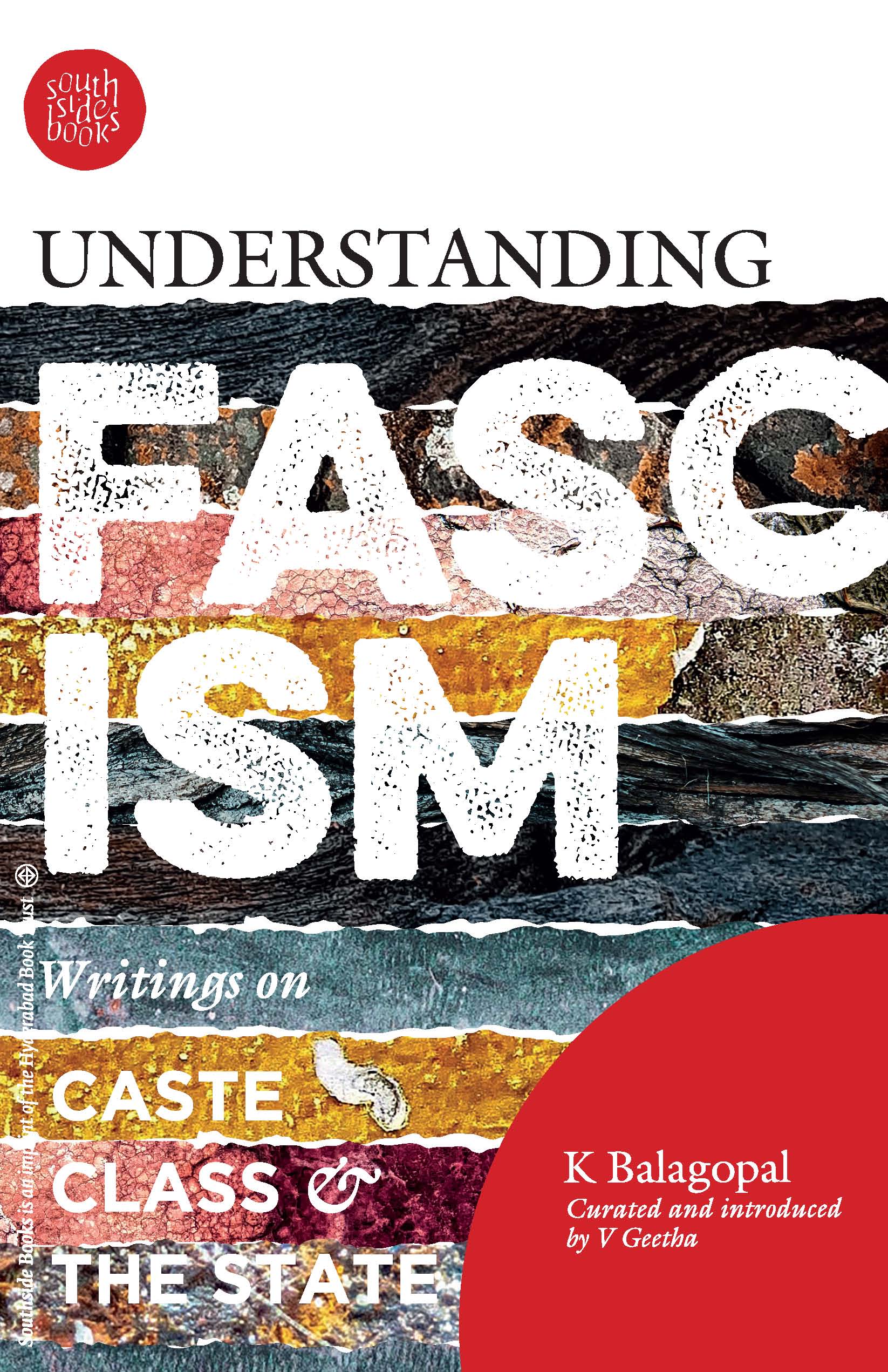Fascist Assault on the Working Class – Clifton D’Rozario
Talk given at the 13th Balagopal Memorial Meeting held on 9th October 2022 at Hyderabad and organised by Human Rights Forum (HRF) (Published in Liberation, Central Organ of CPI(ML) on 22 October 2022)
One does not go to a convention against fascism to get hold of a definitive analysis of fascism. One goes there to see what fascism means and does to people of different modes of existence, and how – and how effectively – they are resisting it.- K. Balagopal [1]
The working class is being rendered evermore precarious with insecure jobs, lack of social security, exploitative working conditions, low wages, and union-busting. The reality is that over 90% of the workers are in unorganised sector[2] and 60% workers earn less than Rs. 375/- per day. Unemployment, is in fact, at a 40-year high. Indeed the precariousness of workers today is reflected by the fact that daily-wage workers account for more than 25% of the deaths by suicides annually in the country, which was a staggering 42,000 lives lost. Majority of workers belong to the category of the working poor, having to negotiate their daily needs through uncertain livelihood opportunities that make them, in the words of Jan Breman “wage hunters and gatherers” and “footloose labourers”.
At the same time, caste-feudal and patriarchal structures continue to dominate in several sectors. For instance, sanitation workers and manual scavengers are mostly Dalit, scheme workers and domestic workers are predominantly women, while bonded labours are mostly Adivasi. The proportion of women workers remaining low even as the gender wage-gap continues to grow.
Not only has the promise of 2 crore jobs been all but forgotten, the Union government’s economic policies continue to snatch existing jobs and exacerbate unemployment. This unemployment crisis is pushing entire sections of workers, particularly those from marginalised and oppressed sections, back into poverty, debt-traps, insecure livelihoods, hunger and further marginalisation.
Fascist assault on the working class
The spectre of Fascism looms large over India. Indeed there is battle for the idea of India, which has no parallels in history. Many people make the mistake of equating today’s political situation with the Emergency forgetting the fundamental distinguishing features, most importantly that the present-day Indian brand of fascism is rooted in ideology, Hindutva if you please, and the Union government with Modi as its face, is the front-office of RSS and its vast network of organisations.
Some of the stand-out features of the Indian brand of fascism commonly deliberated upon include the mockery of the Constitution and parliamentary democracy, dismantling of institutions of democracy and accountability, persecution of any ideological dissent, the discourse of Hindutva nationalism, the privatisation of violence in hands of Hindu supremacist organisations, the coding of Hindutva into the law (abrogation of Article 370, Citizenship Amendment Act, proscribing Hijab in education institutions in Karnataka, etc.), the unprecedented communal polarisation and marginalisation of Muslims and the consolidation of caste and belligerent caste aggression, and of course the naked pro-corporate agenda of Modi regime.
Another core feature is the open ruling class war being waged on the working class on four key planks.
Neoliberal policies, corporate Raj and crony capitalism
“A populist fascism, for instance, would today have made a big show of opposing the new economic policy. The BJP will not only not do that, it offers the most brazen arguments in defence of liberalisation of the economy.” – K. Balagopal [3]
The neoliberal prescriptions to the global economic crisis, of liberalisation, privatisation, globalisation and withdrawal of the welfare state, have decimated the lives of workers causing increasing unemployment, precarious working and living conditions, and ever-sharpening inequality. Unsurprisingly, this has provided a base for fascist and authoritarian regimes to come to power across the world. In this overall global climate of rise in reactionary bourgeois regimes, Hindutva fascism returns in the unconditional defence of a crisis-ridden capitalism.
The entire Indian economy is now opened to foreign capital, whether in the name of ‘Make in India’ or ‘National Monetisation Pipeline’, through systematic privatisation and outright sale of public sector establishments. This along with the combined effect of demonetisation, GST and the authoritarian imposition of lockdown has further pauperised the workers with the parallel unprecedented increase in the wealth of the corporates and elite. The concentration of wealth in the hands of a few corporates (Adani’s wealth has grown thirty-fold over the past eight years) as a result of transferring public assets and resources to the corporates, enabling monopolies in all sectors, is the result of the most brazen variety of crony capitalism.
One of the direct consequences of this transfer of public assets into the hands of corporates, is that the employees will be thrown out of their jobs and the reservation policy for the Scheduled Castes and Scheduled Tribes will be abandoned.
A taste of things to come is evident from the experience of Air India. On 8th October 8, 2021, the Union government announced the sale of Air India to the Tatas. In June 2022, Tata-owned Air India launched a Voluntary Retirement Scheme (VRS) for its employees while at the same time announcing that it intended to hire the “right persons” for important positions. Hiring and firing simultaneously![4]
Contempt for the workers
The open defence of capital by the Union government is not merely a quid pro quo offered to corporates for fund-rolling the BJP’s election campaigns, but derives from an ideology that is inherently anti-worker. At its core, Hindutva fascism has sheer contempt for workers as rights-bearing, militant, non-submissive, organised citizens demanding their due of what their labour power has produced, as a step towards the capture of state power. On the contrary, it patronises a relationship between the employers and the workers, premised on servility and subservience.
Relentlessly batting for corporates, Modi has condemned the “culture of criticizing industry and corporates” since he believes they are doing exemplary social work alongside their business. In his election victory speech on 26th May 2019 he stated: “Now, there are only two castes living in the country and the country is going to be focused on these two castes. In the 21st century, there is a caste in India, the poor, and other castes in the country who have some contribution to free them of poverty. There are the ones who want to come out of poverty and the one who wants to bring people out of poverty. We have to empower these two.” Immediately thereafter, in his Independence Day speech on 15th August 2019, Modi celebrated wealth creation is a great national service, and warned against seeing “wealth creators with suspicion”.
In the eyes of this regime, the workers whose labour power produces everything, are not the wealth creators. On the contrary the corporates, who accumulate wealth by the sheer exploitation of labour and resources, are supposedly the wealth creators and while workers are to be grateful to them!
One of the many policy attacks on the working class was demonetisation which caused untold devastation with workers struggling to meet expenses of basic needs including food, medical expenses, school fees, transport, etc. Compelled to stand in long queues for days on end, workers lost their livelihood and wages. Utter contempt marked the manner in which this was imposed and implemented.
The 4-hour notice for imposing the Covid lockdown further revealed this contempt for workers, their lives and livelihoods. Announced on 24th March, the last week of the month, it enabled employers to deny workers their wages thereby facilitating wage-theft. Workers and their families faced impoverishment, starvation and destitution. Migrant workers were compelled to walk back to their homes thousands of kilometres and many hundreds lost their lives. indignity was heaped on the migrants in various ways. In Bareilly, UP they were sprayed with disinfectants in the middle of the road, while in Bihar they were refused entry at the border itself. Incidentally in June, 2022, the UP government earned Rs 21 lakhs from auctioning the thousands of cycles confiscated from laborers going towards their homes in lockdown!
The contempt for workers is further seen in the increasing criminalisation of working class struggles. The migrant workers in Surat, who during the Covid lockdown, protested demanding that they be allowed to return to their homes, were tear gassed, lathi charged and then arrested. Another shocking indication of this trend is the experience of the 5 contract workers working at Reliance Energy Ltd., Mumbai and members of the Mumbai Electric Employees Union, fighting against the precarious working conditions and for the basic rights of workers. They were implicated in false cases and charged under UAPA for their Union activities. They have since been released on bail after spending between 2-3 years in jail. Incidentally one of the allegations against them is that deliberately stopped the work of Reliance Energy Ltd. for one day! With the coming of the new Labour Codes, the Union government has made clear its intent of destroying even the most basic rights of workers and any struggles against it will be met with brute force.
Dismantling the existing labour law protections
In previous regimes we have witnessed two strategies to deny workers the benefits of existing labour laws. The first strategy par excellence, which has defined labour law, ever since its inception, has been the startling discordance between the law on the books and the law in action. The fact that these legislations were not being fully implemented reduced workers to a condition of precarity. The second is the gradual whittling away of labour protections through judicial interpretation. The locus classicus (among many others) in this hall of constitutional shame is the judgment in SAIL, which has effectively gutted the Contract Labour (Regulation and Abolition) Act, 1970.
Now, what we are witnessing is the complete dismantling of entire labour law protections itself. Even as the country was battling Covid, the Union Labour Ministry issued a communication on 05.05.2020 to all the State Governments mandating that in order to address the “… challenges emerged due to COVID-19 pandemic, it is requested to undertake labour reforms on priority basis”, namely enabling self-certification, reduced inspection system, and effecting labour law changes including:
- Increase in threshold from 100 to 300 workers under the ID Act
- Increase in threshold under the Contract Labour Act from existing 20 workers to 80 workers
- Increase in threshold under the Factories Act from 10 (with power) and 20 (without aid of power) to 20 and 40 respectively
- Fixed term employment
- Increasing working hours from 8 to 12
Simultaneously the Union government went ahead with getting the 4 Labour Codes passed in Parliament, thereby declaring a veritable war on the working class. These Labour Codes take away most hard-won rights of the workers. They have increased the thresholds for applicability thereby placing workers outside the protection of law, attacks the workers’ rights to organise and strike, withdraws several protections to women workers, institutionalises contract labour, etc.
Importantly the Labour Codes are an attack on the workers rights as envisaged in the Constitution. For instance, while the Constitution envisages “living wages”, the Codes institutionalise “starvation wages”; the Constitution mandates state policy towards participation of workers in management of industries whereas the Codes institutionalise dictatorship of the employers.
Interestingly Ambedkar, who the Sangh Parivar pays pretentious respect to, had this to say, which has huge relevance!
“In an economic system employing armies of workers, producing goods en masse at regular intervals someone must make rules so that workers will work and the wheels of industry run on. If the State does not do it the private employer will. Life otherwise will become impossible. In other words what is called liberty from the control of the State is another name for the dictatorship of the private employer. How to prevent such a thing happening? How to protect the unemployed as well as the employed from being cheated out of their Fundamental Rights to life, liberty and pursuit of happiness ? The useful remedy …is to invoke the ordinary power of the Legislature to restrain the more powerful individual from imposing arbitrary restraints on the less powerful in the economic field. It seeks to limit not only the power of Government to impose arbitrary restraints but also of the more powerful individuals or to be more precise to eliminate the possibility of the more powerful having the power to impose arbitrary restraints on the less powerful by withdrawing from the control he has over the economic life of people.”[5]
Manufacturing consent for Hindutva among the working class
Another plank of attack on the working class is the concerted effort to blunt the revolutionary potential of the working class and simultaneously manufacture consent for Hindutva. It must be understood that the neoliberal project necessarily requires the crushing of the organising and fighting capacity of the working class and their trade unions. This has now coalesced with Hindutva, an ideology that eschews a class-conscious militant working class.
We have reached a stage where a section of workers subscribe to the communal, Manuvadi and fascist political ideas and influence. Studies reveal that, even during the colonial period, sections of the working class were seen to participate in communal violence. Instead of “class consciousness”, these sections of workers exhibited some “community consciousness” but this could not deter their unity in working class struggles. Today, however we are faced with a section of workers who are completely persuaded by the ideology of Hindutva.
In no uncertain terms this has been facilitated by an uninterrupted continuity of ideology and mobilisation of the masses, particularly the working class by the Sangh Parivar. Let’s remember that the Bharatiya Mazdoor Sangh (BMS) has been engaged in the mobilization of workers under the banner of Hindu nationalism for decades.[6] Formed in 1955, BMS was established to work among the working class with RSS ideals. It claims that “Bharatiya culture” forms its ideological basis and “that National goal cannot be achieved if there exists any feeling of enmity” and “all the constituents should act and work in unison”, which can be achieved by “developing the concept of “family” in the industry.” On this basis, BMS outrightly rejects class struggle, and promotes the concept of “industrial family”. Comprising more than 5000 affiliate unions It has a membership of almost 1 crore in all States and is the largest central trade union in the country. It has played an instrumental role in blunting workers’ class consciousness and manufacturing consent for Hindu nationalism.
Moreover, informalisation and poverty coupled with communal riots in previous decades, and a fascist ideological onslaught now, make workers an easy prey to fascist political influences. Jan Breman while studying the communal riots in Ahmedabad argues that there is “a direct causal relationship between the massive expulsion of labor from the formal sector of the city economy and the eruption of communal violence at the end of the twentieth century.”
Resisting fascism
If Hindu Raj does become a fact it will no doubt be the greatest calamity for this country. It is a menace to liberty, equality and fraternity. On that account it is incompatible with democracy. Hindu Raj must be prevented at any cost. – Ambedkar
The working class has a history, and the subjective necessity to fight this fascist assault. During the Indian freedom struggle, workers again and again rebuffed divisive communal politics and united to deliver spirited blows to the colonial powers. Even a fascist Nazi rule faced a fight-back in the form of, what Thimothy Mason calls, political resistance of the German working class and workers’ opposition.
More recently, we have witnessed the heroic struggle of the farmers, one of the largest protests in independent India. The Union government bulldozed its way in Parliament to pass the 3 anti-farmer pro-corporate laws, yet the unprecedented farmers’ movement brought this tyrannical regime to its knees. The Union government, with the media as its mouthpiece, failed despite all possible tricks to demonise and divide the farmers. Indeed it was a defeated Union government that was compelled to finally repeal the farm laws.
The working class has to draw inspiration from this courageous farmers’ resistance and mount a spirited resistance to this fascist assault. Militant struggles, without falling into the trap of economism, have to be the guiding norm. The joint central trade union protests and strikes are necessary, but insufficient. To escape the trap of economism, it must be understood that the class question being a social question, class struggle cannot be solely economic struggle and is basically the struggle against all economic and social oppression including class, caste and gender. In particular gender equality and the annihilation of caste must be an integral part of the working class organising and struggles. Fighting communal divisions is a principal task of the working class, not because they divide the working class, but because these are facets of the Indian brand of fascism that spells disaster for the entire country. These are part and parcel of the democratisation that is necessary for any justice to the working class.
As against “communal consciousness”, we must strive for real unity of, and fraternity amongst, the working class. Bhagat Singh who saw revolutionary Marxism as the answer to communalism, was of the view that: “To prevent people from fighting each other, “class consciousness” is the need of the day. The poor labourers and the farmers must be clearly taught that their real enemies are the capitalists”. This can be effectively done by moving beyond the confines of the factory gates, and building the movement of the working class in their localities and as citizens.
Balagopal [7] said:
The only hope is the resistance that the people have been expressing time and again, and their capacity for not only uncontrolled outbursts but also disciplined and organised protest… It would be cheating oneself to believe that the resistance is strong enough to overcome the fascist onslaught; but then it is only by courageously facing the onslaught that resistance can strengthen itself.
Workers, desirous of a life of dignity, have no choice but to fight this assault. Let us draw hope from the struggles against fascism growing across the country.
After all, this is a resistible fascism!
Notes:
[1] “Rise of Gangsterism in Politics”, Economic and Political Weekly, February 4, 1989
[2] As of 2018, India had about 461 million workers (some estimates put it at 470 million), with 80% of them working in the informal sector, such as in agricultural work and in MSMEs with not more than 10 workers. The remaining 92 million workers are designated as being in the formal sector, of whom 49 million are employed as informal workers and called variously as contract labour, daily wagers, outsourced staff, etc.
[3] “Why did December 6, 1992 happen”, Economic and Political Weekly, April 24, 1993
[4] https://www.freepressjournal.in/analysis/tatas-aim-to-right-size-air-india-by-hiring-and-firing-simultaneously
[5] Appendices, States and Minorities
[6] “Workers and the Right Wing: the Situation in India”, Smriti Upadhyay, Johns Hopkins University
[7] Supra note 2
Fascist-Assault-on-the-Working-Class-_-Liberation-Central-Organ-of-CPIML









